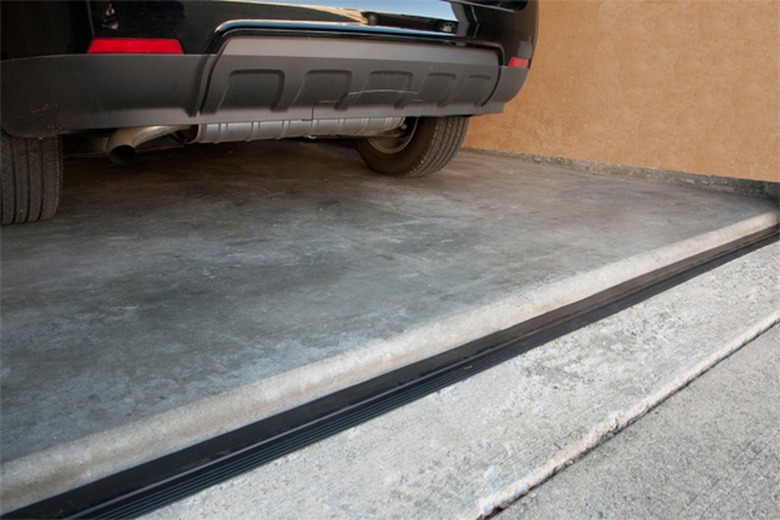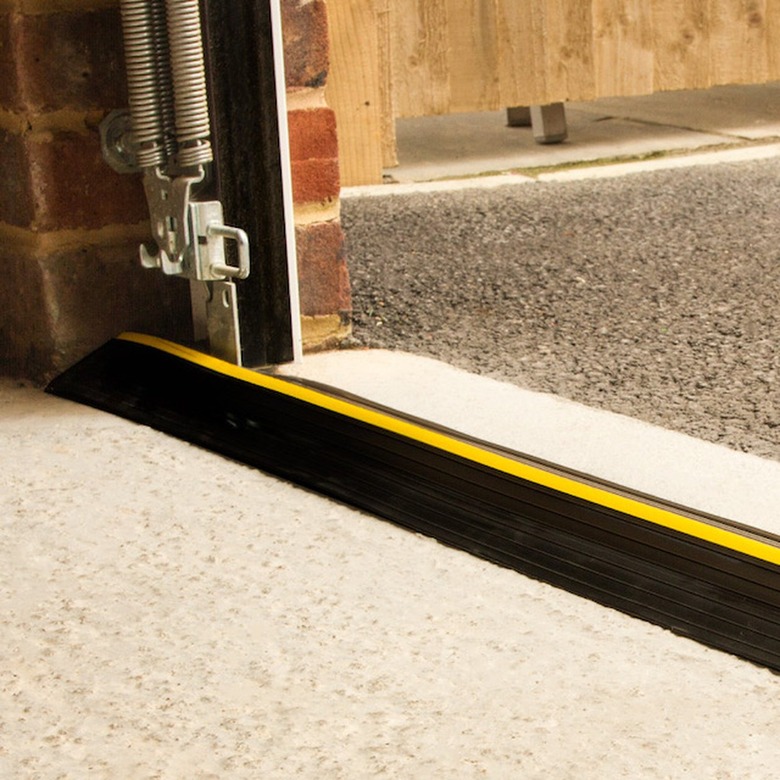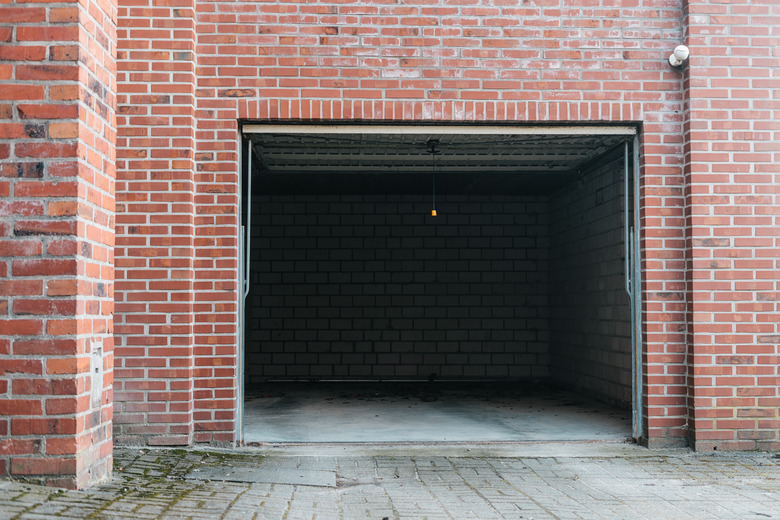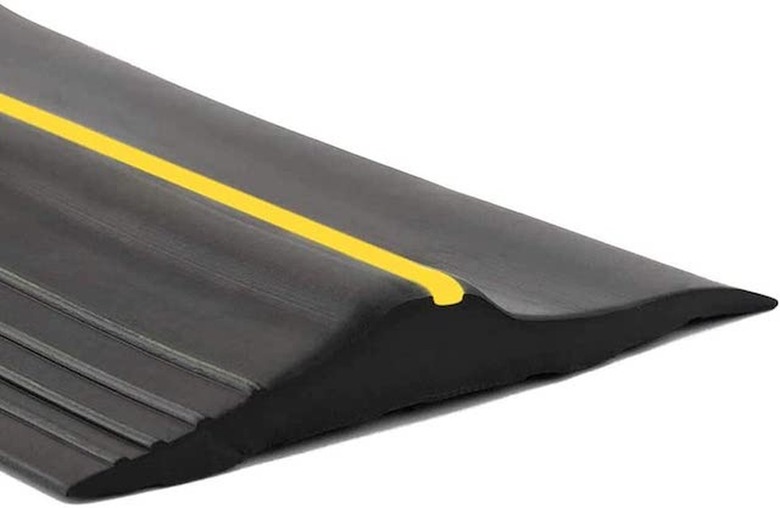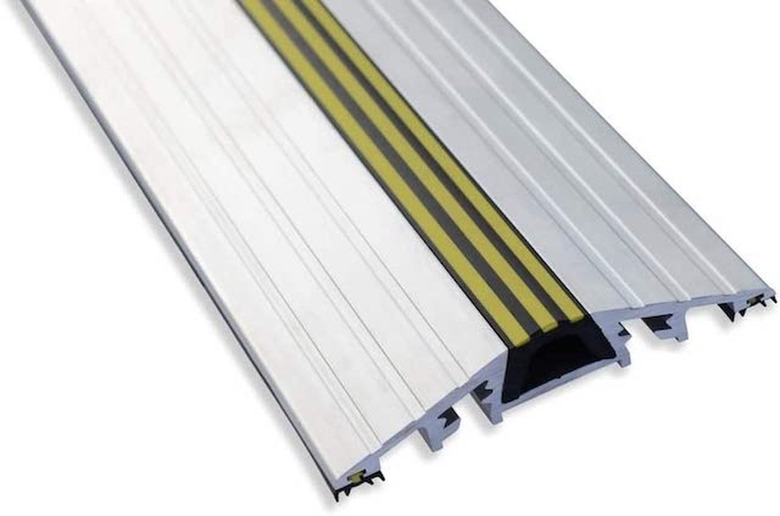What Is A Garage Door Threshold?
We may receive a commission on purchases made from links.
If you don't already have a garage door threshold, chances are you need one. Like the threshold on the front door to your house, a garage door threshold is a type of weatherstripping that keeps warm air in the garage while sealing out cold air, rainwater, snow, and blowing debris. It forms a better seal than a garage door bottom seal and does a better job of keeping out rodents, bugs, and other critters you don't want in the garage.
A garage door threshold is easier to install than a threshold for an entry door, and in most cases, all you have to do is glue it to the garage floor. Fasteners, like screws and nails, aren't usually needed, although that depends on the type of threshold you choose. The entire DIY installation, which you can easily complete in an hour or two, shouldn't cost more than $100. That's a small price to pay for a warmer, drier, pest-free garage.
Why Do I Need a Garage Door Threshold?
Why Do I Need a Garage Door Threshold?
Go inside your garage, close the garage door, and check the bottom edge where it meets the floor. If you can see daylight at any point along the bottom of the garage door, you're losing heat through those gaps. If the garage is attached to your house and even if it's insulated, that heat loss is probably driving up your energy costs. Even if you have a detached garage and aren't worried about heat loss, anything you store in it is at risk of being damaged by the moisture that comes in, not to mention the fact that leaves and dust blow in through those gaps, making a mess inside the garage.
And speaking of moisture, another sign that you need a threshold is rainwater incursion into the garage. When it rains, water drains down along the outside of the door, and if the pavement doesn't slope directly away from the door, some of that water is bound to form puddles on the garage floor. In some cases, the water level in the garage can be considerable, creating humid conditions and slipping hazards and staining the floor.
By itself, a garage door bottom seal doesn't prevent this as effectively as a threshold, especially if the pavement isn't level and the bottom seal doesn't make contact with the pavement for the entire width of the door. Together, however, a bottom seal and threshold form a garage door weather seal that can keep out pretty much everything, and if you insulate the door (and add a heat source if necessary), you have a fairly cozy garage for projects or even a full-fledged hangout spot.
Types of Garage Door Thresholds
Types of Garage Door Thresholds
A garage door threshold is a strip of waterproof material sealed to the garage floor directly under the door that runs along the width. Typically 3 to 4 inches wide, it tapers from floor level on both sides to rise to a height between 1/2 inch and 2 inches. The best height for your garage depends on the amount of gap between the bottom of the door and the floor as well as the severity of any water incursion problem you might have. Most thresholds have a groove in the top into which the garage door bottom seal fits, so when the door is closed, the combination forms an effective garage door threshold seal.
The easiest type of threshold to install is one made of EPDM rubber, which is completely waterproof and so flexible and workable that you can cut it with a knife. You can also opt for an aluminum threshold, which is a bit more challenging to install because you have to screw it to the floor. Aluminum thresholds don't offer many advantages over rubber ones, although they may look better to some people. If you're going to install a floor threshold as a DIY project, you're better off choosing a rubber one since it doesn't require you to drill holes into the concrete floor.
The standard length for a garage door threshold is 20 feet, which is more than enough to span most garage door openings, and you can even purchase custom-cut thresholds designed to fit standard door widths. If you have a triple-car garage with an opening that exceeds 20 feet, you should purchase a longer threshold to avoid having a seam or a gap where two sections meet. Thresholds are available in 40-foot lengths and in rolls up to 100 feet long.
Choosing a Threshold for Your Door
Choosing a Threshold for Your Door
The main consideration when choosing a threshold for your garage is that it's high enough to form a tight seal with the bottom of the garage door. To determine the height, close the door and measure the height of any gaps you see along the entire width of the door. The threshold needs to be high enough to seal the tallest of these gaps.
Tip
Note that the threshold is designed to accommodate the garage door bottom seal, so if your door doesn't have a bottom seal, you should install one before measuring for the threshold.
If water incursion is a problem and you need a storm shield to keep it out, you'll want a threshold high enough to act as a dam, and this height may be more than is needed to close all the gaps. In that case, you might have to adjust the close limit of the door opener to prevent the door from closing too tightly and compressing the bottom door seal against the threshold. Luckily, garage door openers have adjustment devices that make it easy to raise the height of the door when it's closed.
You basically need two things to install a garage door threshold: the threshold itself and sealant to affix it to the garage floor. For easy installation, it's best to choose a garage door threshold seal kit that includes the sealant, but if your threshold comes without it, a standard construction adhesive will work.
Things Needed
-
Broom
-
Pencil
How to Install a Rubber Garage Door Threshold
How to Install a Rubber Garage Door Threshold
Garage door thresholds are designed for easy installation, so this home improvement project is one you can complete even if you don't have much DIY experience. To ensure a successful installation, choose a dry day with moderate temperatures.
1. Clean the Floor Under the Door
Sweep the floor and then wash it down with a strong soap solution, such as 1/2 cup of trisodium phosphate per gallon of water, to remove grease and oil that could prevent the sealant from adhering. If the floor is painted, etch the paint under where the threshold is going to be placed using a wire brush. Make sure the floor is completely dry before you proceed.
2. Measure and Cut the Threshold
Measure the distance between the outside edges of the door roller tracks using a tape measure and cut the threshold to that length using a utility knife.
3. Notch the Ends of the Threshold
Lay the threshold on the floor just behind the door tracks and align the ends with the outside edges of the tracks. Draw a line on each end that marks the inside edge of the track. Measure the distance from the front (outdoor side) of each track to the back (garage side). Measure this distance along the line you marked, starting at the front edge of the threshold, and mark a perpendicular line at this distance from the first line to the end of the threshold. Using a utility knife, cut a notch along these lines to allow the threshold to fit between the tracks.
4. Fine-Tune the Threshold Placement
Set the threshold in position on the floor with the notches fitting around the door tracks and then close the garage door. The bottom seal should fit snugly in the groove in the top of the threshold, and the hump on the threshold should be flush against the inside of the door when it's closed. Open the door and move the threshold back or forward as needed if the door seal doesn't line up properly. You may have to cut the notches a little deeper to do this. When the threshold is placed properly, draw lines on the floor along the front and back edges of the threshold using a pencil and then remove the threshold.
5. Spread Sealant on the Floor
Put a tube of sealant into a caulk gun and apply the sealant on the floor between the lines of the outline you marked. Run a bead of sealant around the perimeter, staying about 1/2 inch away from your pencil lines. Then, fill in the middle with a continuous bead that extends from one edge of the outline to the other in an S-pattern. You want to make sure that all parts of the threshold stick to the floor, so apply the sealant generously.
6. Install the Threshold
Wipe down the back of the threshold to remove dust and grease and then put it back in place and press down on it to compress it into the sealant, working your way from one end to the other and keeping the threshold aligned with your pencil lines. Wipe away any sealant that oozes out from under the threshold. Spread sealant in the gaps between the threshold and the door track to prevent water from getting in. Close the door to hold the threshold firmly to the floor and leave the door closed for 24 hours to give the sealant time to cure.
How to Install an Aluminum Threshold
How to Install an Aluminum Threshold
The procedure for installing an aluminum threshold is similar to that for installing a rubber one, but you have to cut it with a hacksaw rather than a knife. Since you also have to screw it to the floor, you need to mark the screw holes on the floor after getting the threshold into the right position. Drill a hole for a screw anchor on each mark using a drill (preferably with a hammer drill function) and a concrete bit and tap in the anchor. Spread a bead of silicone caulk along the front and back edge of the threshold to seal out water and then screw the threshold to the floor with corrosion-resistant concrete screws. With caulk, finish by sealing the ends of the threshold where they meet the door tracks.
Some aluminum thresholds are peel-and-stick. If you have one of these, cut it to length, notch the edges, and then peel off the protective backing and stick the threshold to the floor. Choose this type of threshold only if the floor is level and free of chips or gouges.
